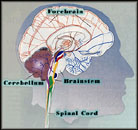Post Concussion Symptoms: Brain Injury Symptomatology
As discussed in detail elsewhere in this web page, concussion results in organic injury to the brain, in most cases, by the mechanism of diffuse axonal injury. This injury is more likely the a result of strain to axons than actual tearing, resulting in a cascade of events which can disrupt a significant number of neural connections, because of the death or damage to the axons which connect the neuron bodies. Our current research into neuropathology indicates that significant regeneration of these neural connections can occur, but that the extent of such regeneration falls off considerably with age and that the regenerated neural connections are less efficient than premorbid. For this reason, individuals in professions which place a high demand on processing speed, are more likely to experience deficits than others, and most people who have suffered more than a Grade I concussion, will have some post concussion symptoms and measurable deficits, if sufficient demands are made upon their brains.
 This page is primarily focused on understanding why concussion can result in permanent, although subtle, disability. Thus, this page will not include a classic discussion of the full line of symptomatology which relates to pathology in a particular part of brain, i.e., focal brain pathology. Instead, it will focus on the organic reduction in abilities that can naturally flow from concussion, and the effect of these deficits on the overall functioning of the brain, which by very nature of our existence as emotional beings, can be expected to have profound effects on the psyche.
This page is primarily focused on understanding why concussion can result in permanent, although subtle, disability. Thus, this page will not include a classic discussion of the full line of symptomatology which relates to pathology in a particular part of brain, i.e., focal brain pathology. Instead, it will focus on the organic reduction in abilities that can naturally flow from concussion, and the effect of these deficits on the overall functioning of the brain, which by very nature of our existence as emotional beings, can be expected to have profound effects on the psyche.
There is a second focus of symptomatology that our primary focus does not cover. Not all, “so called mild” brain injuries, are purely diffuse in nature. To go back to the discussion of diffuse versus focal brain injuries, click here. The mistake in over emphasizing the diffuse nature of post concussion symptoms, is that it presumes that the medical community would have diagnosed, in the acute stage, all focal injuries. Our emergency medical system is focused almost entirely on “interventions” such as saving a life and stopping the bleeding. In such a system, the thorough type of neurological exam, and follow up to such exam, is rarely administered. And even the best neurological exam will not identify all focal pathologies. Further, while CT and MRI are better at identifying focal injuries than diffuse, focal injuries can also be microscopic, meaning they are too small to be seen with such technology.
Thus, the entire constellation of post concussion symptoms associated with focal injuries, may occur to people who were thought to have merely a concussion. In the future, this page may address the full gamet of that symptomotology, but for now, we will address only those which are most common with underdiagnosed brain injury.
Symtpomatology of Subtle Brain Injury